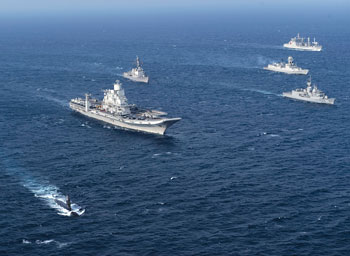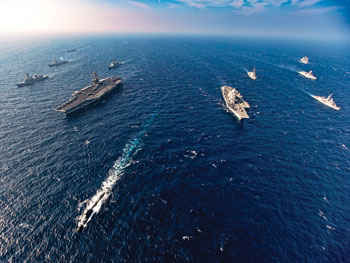INDIAN ARMED FORCES CHIEFS ON OUR RELENTLESS AND FOCUSED PUBLISHING EFFORTS

The insightful articles, inspiring narrations and analytical perspectives presented by the Editorial Team, establish an alluring connect with the reader. My compliments and best wishes to SP Guide Publications.

"Over the past 60 years, the growth of SP Guide Publications has mirrored the rising stature of Indian Navy. Its well-researched and informative magazines on Defence and Aerospace sector have served to shape an educated opinion of our military personnel, policy makers and the public alike. I wish SP's Publication team continued success, fair winds and following seas in all future endeavour!"

Since, its inception in 1964, SP Guide Publications has consistently demonstrated commitment to high-quality journalism in the aerospace and defence sectors, earning a well-deserved reputation as Asia's largest media house in this domain. I wish SP Guide Publications continued success in its pursuit of excellence.
- MoD initiates comprehensive review of Defence Acquisition Procedure 2020, pushes for defence reforms
- G7: The Swansong
- Kalinga Connect: South Asia to Polynesia
- Advanced MRSAM for India for a greater firepower
- Must Credit DRDO for Operation Sindoor, now what is next for defence R&D?
- Operation Sindoor | Day 2 DGMOs Briefing
- Operation Sindoor: Resolute yet Restrained
INDO-PACIFIC / QUAD
A Rattled China: Cementing of the Quad
The QUAD is an effort by the Indo-Pacific powers to deter China’s ability to challenge and disrupt the rules-based order and the status quo in the Indo-Pacific region. The US is keen on institutionalising the QUAD and wants to shape it on the lines of NATO, an Asian NATO of sorts.
 | The Author is an independent Geopolitics and Security analyst. She has held honorary positions in various organisations and has a number of published works among her credentials. She has also been associated with Future Directions International, as a Visiting Fellow in the Indo Pacific Research Programme since 2012. Saloni Salil contributes to the growing discourse on the concept of the Indo-Pacific and major power intentions in that region. |


Alliances are often seen as “important tools for overcoming the constraints of geopolitics, and for changing the meaning of the supposedly ‘permanent’ nature of international geography” 1. Taking a cue from the above, one can see the Quadrilateral Security Dialogue or QUAD as coming together of four Indo Pacific powers, which were earlier hesitant, to thwart Beijing’s aggression.
In the current scenario, all four countries i.e. United States, India, Japan and Australia have faced China’s unrelenting aggression and its willingness to use the “economic interdependencies to try to level informal sanctions to punish countries that oppose it”2. The relations between China and US have been confrontational for a while now, from trade wars to coronavirus, Hong Kong and human rights issues, intimidation of Taiwan and Philippines by China. With India, both nations have locked horns in a tense military standoff in Eastern Ladakh. China has once again reignited its dispute with Japan over the Senkaku/Diaoyu Islands. The relations between Australia and China after months of back and forth have reached an all-time low. Apart from this, China has been land-grabbing in Nepal, Bhutan (China has been involved in land grabs in almost 18 countries, some under the corporate veil while some under open intimidation).
There is a global chorus against China, with even European nations like France, Canada and recently Germany coming into the foray having unveiled their Indo-Pacific strategy owing to the growing threat to open and free trade regime, threatening world’s economy and jeopardising global environment.
QUAD 2.0 And Growing Beijing’s Anxiety
China views the QUAD and Malabar as premeditated attempt to encircle it to curb Chinese ambitions and hegemonistic agendas in the region by intensifying multilateralism. Also the cementing of the like-minded nations alliances in the Indo-Pacific leading to drawing of an Iron curtain of sorts. “The sharpening of the collective naval element of the QUAD countries is being addressed through the MALABAR. With focussed exercises improving and, further ahead, likely to improvise upon the present tenets of the MALABAR which include strategic wargaming, tactical uplift, and naval friendliness, China’s Peoples’ Liberation Army Navy (PLAN) is likely to be perturbed.”3
“With focussed exercises improving and, further ahead, likely to improvise upon the present tenets of the MALABAR which include strategic wargaming, tactical uplift, and naval friendliness, China’s Peoples’ Liberation Army Navy (PLAN) is likely to be perturbed”
With bolstering of ties between Beijing’s immediate neighbours with traditional powers “the prevalence of this uneasiness in the Chinese state machinery is epitomised by a panoply of rigid, vigorous, and diverse set of mushrooming relationships between India-Japan, India-US, India-Australia, Australia-US, Australia-India-Japan, and several more. More so, the broader security domain is being prioritised above soft undertakings.”4
China has always been vocal about its angst against such alliances. China also recently, “has accused the United States of trying to ‘create chaos’ in the Asia-Pacific, a day after US National Security Advisor Robert O’Brien, on a visit to the Philippines, backed countries in maritime disputes with China and accused Beijing of using military pressure to further its own interests”5 and “the formalisation of the QUAD is guaranteed to infuriate China but no one is certain how Beijing will respond. While a conventional war remains out of question, China could resort to non-conventional warfare tactics such as cyber-attacks, proxy wars, insurgency etc.”6
Conclusion
The Quad 2.0 is an effort by the Indo-Pacific powers to “deter China’s ability to challenge and disrupt the rules-based order and the status quo in the Indo-Pacific region. It’s a signalling that they are and they would get even more serious about acting as a military and strategic counterweight to China, if Beijing were to continue to challenge [the status quo], not just in the South China Sea but also in the Indian Ocean.”7 But all is not well, the QUAD nations amongst themselves are not on the same pedestal in terms of shared desires and strategic interests. Also a lot of nations in the region are uncomfortable with the cementing of the QUAD more tightly despite the threats faced by them vis-à-vis China because this may lead to further destabilising the region by constant militarisation.
“The formalisation of the QUAD is guaranteed to infuriate China but no one is certain how Beijing will respond. While a conventional war remains out of question, China could resort to nonconventional warfare tactics.”
“The QUAD is often called a coalition without commitment. It, in its present form, is nebulous without a structure or a secretariat. The United States is keen on institutionalising the QUAD and wants to shape it on the lines of the North Atlantic Treaty Organisation (NATO), an Asian NATO of sorts. It seeks to militarise the alliance”8. But the other QUAD members do not wish to present this alliance as a counter-weight to China because in the age of interdependence, economic stability is over and above ideological differences and therefore, instead they should use the grouping as a diplomatic weight against Beijing’s aggressiveness and reiterate faith in multilateralism and regionalism.
References
- Harvey Starr and Radolph M. Siverson, “Alliances and Geopolitics”, Political Geography Quarterly (July:1990), Vol.9, Issue. 3, pgs 232-248
- Zaheena Rasheed, “What is the QUAD and can it counter China’s Rise?”, November 25th 2020
- Jay Maniyar, “QUAD and The Malabar: A Concern for China”, The Diplomatist, December 2nd 2020
- Ibid.4 (Jay Maniyar)
- “China accuses ‘dangerous’ US of creating chaos in Asia”, November 24th 2020
- “China’s Worst Nightmare ‘QUAD’ Becoming A Reality As US Holds Naval Drills With India, Australia, Japan”, July 22nd 2020
- Zaheena Rasheed, “What is the QUAD and can it counter China’s Rise?”, November 25th 2020
- Adithi Gurkar, “QUAD: Here Are The Profits And Pitfalls For India If We Formalise An Anti-China Bloc”, October 16th 2020





